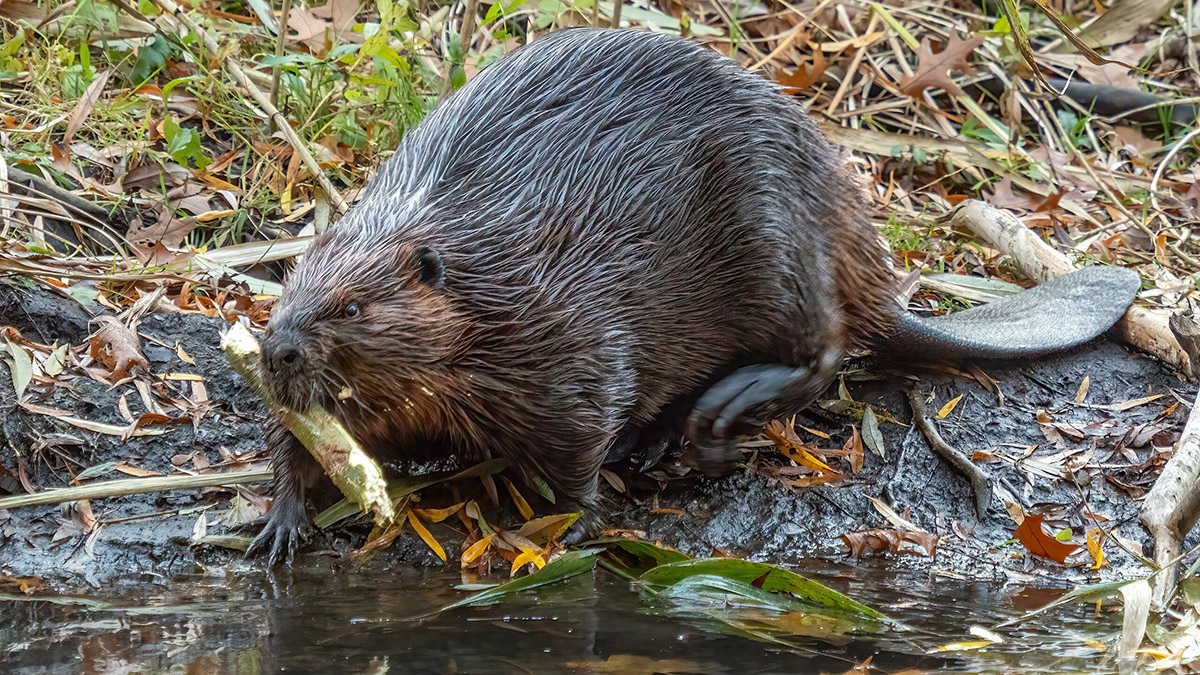Industrious, sharp-toothed and loyal, castor canadensis, more commonly known as the North American beaver, is now in its 50th year as an official symbol of Canada.
The beaver is among some pretty elite company in the symbols department. Think national anthem-level elite. On March 24, 1975, with the adoption of the National Symbols of Canada Act, the beaver was recognized as a symbol of Canadian sovereignty.
Five decades later, that special status doesn’t seem to offer the beaver the requisite first-class treatment. Trapping is embedded in Canada’s long historical relationship with the national animal and remains the choice for many municipalities handling beaver problems. Experts say this practice is problematic, as beavers aren’t just a symbol of Canada’s history, but also hold great promise for the future.
“Now they’re mostly just hunted because they’re deemed a pest species. But during the fur trade era, they were hunted nearly to extinction for their pelts,” says Holly Kinas with Alberta-based Working with Beavers, a group that aims to educate Canadians about coexisting with their national animal.
In the colonial period, beavers were trapped and killed for their fur, which was highly prized in Europe. Demand for the stylish garments made from beaver pelts meant trappers had to move further inland, chasing the furry gold. Many corporations made their fortunes off beaver pelts and that fuelled industrialization.
“Hudson’s Bay Company was one of the biggest global industrial organizations in the world at the time and the fur trade was the centre of it. So beavers helped create Canada as a country, as a construct of colonization,” says Glynnis Hood, an ecologist and professor at University of Alberta. She is also the author of The Beaver Manifesto, a 2011 bookthat explores the role of beavers as a keystone species.
National Geographic defines keystone species as “organisms that help hold the ecosystem together.” Beavers are ecosystem engineers and landscape shapers and the environments they inhabit would look drastically different without them.
“They create … wetlands. There’s a lot of species that are very dependent on wetlands, insects to fish, amphibians, birds, mammals, the whole suite,” says environmental journalist and author Frances Backhouse.
But still, advocates say they don’t get the protection they deserve.
There’s a real discrepancy in how Canada benefits from the image of the beaver and from beavers, but actually we give nothing back to helping or protecting these animals.
Lesley Fox, executive director of The Fur-Bearers.
“There’s a real discrepancy in how Canada benefits from the image of the beaver and from beavers, but actually we give nothing back to helping or protecting these animals,” says Lesley Fox, executive director of The Fur-Bearers, a Vancouver-based animal advocacy charity.
The Canadian Pacific Railway, Roots and Parks Canada use the beaver as part of their branding. Cartoon beavers can be found in children’s books and tourist shops, selling an image of Canada.
Many places have the beaver in their place names from Beaver Cove, N.L. to Beaver Creek, Yukon.
“It just reflects that there’s no question, the beaver was an important part of Canadian history,” says, Collin Coates, who authored a chapter on the beaver in the 2018 essay collection Symbols of Canada.
But today, beavers are trapped and killed as a nuisance. While there are no statistics on the number killed each year, lethal trapping is a common, routine practice of many municipalities. Their industrious nature means beavers are constantly moving, building and transforming landscapes. In cities, their dams can cause flooding and property damage.
Many municipalities, including the City of Ottawa, opt to use trappers employed by the Ontario Ministry of Natural Resources. The city’s Wildlife Strategy says “where mitigation and avoidance measures are not practical, the [province] recommends lethal trapping.” In a 2023 public meeting, City of Ottawa staff confirmed that they lethally trap 150 beavers per year.
Advocates say it doesn’t have to be this way and effective coexistence is possible.
“It’s very easy from a landowner perspective to just kill and remove them. Very few permits are required, whereas coexisting with them is a newer concept and it’s a little more challenging,” Kinas says.
Tree protection devices, such as wire wrapping, can help in areas where beavers may attempt to gnaw at the base of trees. There are also flow devices, such as culvert protectors, a contraption placed at the base of a culvert that allows water and fish through, but blocks beavers.
Lastly, Kinas supports the use of pond levellers, devices that can be handy in areas where a beaver is in a pond, causing flooding on a property. “It’ll bring that pond down to a level that you are comfortable with, but the beaver can still happily go about its business,” she says.
She also notes these devices are newer and less well known, so the convenience of lethal trapping appeals to many presented with a beaver issue.
One landowner and nature lover, Carolyn Milne, has a beaver problem. She owns 100 acres of swamp land in south-central Ontario. A beaver made its way onto her land, raising the water level and blocking her access point.
At 66 with a bad back, she felt the installation and maintenance of a coexistence device wasn’t an option. Trapping and relocation was also not an option because, in accordance with provincial regulations, beavers can only be moved within a kilometre of their original habitat.
“So as a landowner, I kind of said, ‘Oh, wow, there’s nothing I can do’,” she says. Her solution now? Let it be. But it’s not without frustration.
“Sure they’re our symbol, but they’re a pain in the a–,” says Milne.
Experts say beaver-human coexistence is important for the future with beavers showing great promise as a nature-based climate change solution. Backhouse says she likes to call them “climate change allies.”
Fox says many people do not understand the importance of beavers for our future. Their biggest contribution, she says, is that they keep fresh water on the land.
In this time of climate crisis and forest fires, species extinction and water quality issues, beavers 100 per cent have a role to play. Every time we trap and kill and remove beavers from ecosystems, we risk draining vital wetlands.
Lesley Fox
“So in this time of climate crisis and forest fires, species extinction and water quality issues, beavers 100 per cent have a role to play,” she says. “Every time we trap and kill and remove beavers from ecosystems, we risk draining vital wetlands.”
To Fox, it seems Canada’s only appreciation of the beaver lies in its place as a symbol. But one historian, Michael Dawson, notes that while appreciated, the symbol is not without its flaws.
“The beaver played a role as a key staple in the economic development of the country. Now the irony there is that essentially on the one hand we celebrate the nation’s connection to the beaver, but on some level you’re really celebrating a process that leads to the over-hunting and massacre of this animal,” says Dawson, a professor at St. Thomas University who co-edited Symbols of Canada.
Experts say there’s a lot we can learn from beavers and their inspiring story of resilience.
“Another neat thing about beavers is that they’re sort of this great ecological comeback story,” says Hood, noting how they came back from near-extinction and are now one of the few semi-aquatic mammals not listed as endangered.
“They tell us a lot about resilience and tenacity and the ability to face some really extreme challenges and still be able to succeed,” she says.




